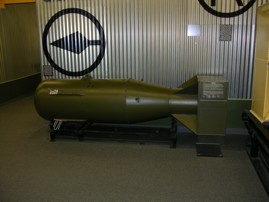 |
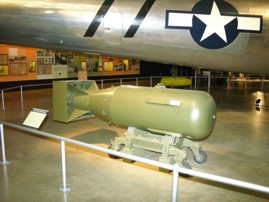 |
 |
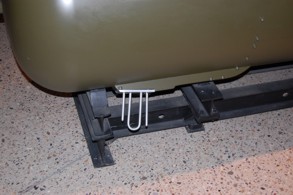 |
 |
Aircraft
delivered,
Free fall nuclear weapons
In
the
US Arsenal
This site should (hopefully) provide a
quick overview of U.S. air dropped nuclear weapons. It
is in no way intended to be an in-depth study. I will
add updates as time and materials allow. All materials
are drawn from unclassified published sources.
Mark 1 Little Boy
Length:
10
Diameter:
2
4
Weight: 8,900 lbs
Yield:
13kt
Notes: The Little Boy was a
crude weapon and not stockpiled in numbers
Mark 3 Fat Man
Length:
10 5
Diameter:
5
Weight: 10,800 lbs
Yield:
23kt
Notes:
Though an effective bomb for only the second one designed, the
Mk 3 had some drawbacks, one of which was the aerodynamic
instability that resulted if (which did happen) any of the
baffles in the tail section came lose during a drop.
 |
 |
 |
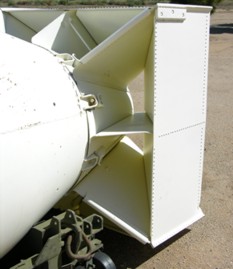 |
 |
Mark 4
Length:
10 8
Diameter:
5
Weight: 10,900 lbs
Yield:
Ranging from 1 to 31kt
Notes:
The
Mark 4 was basically a refined Fat Man with better aerodynamics. (Last photo
USAF photo)
Mark 5
Length:
10 8½
Diameter:
3
7Ύ
Weight: 3,175 lbs
Yield:
40 to 50kt
Notes:
The
Mark 5 was a more practical bomb and stayed in service for
some time. (The last photo shows a Mk 5 to the right of a Mk 6)
Mark 6
Length:
10 8
Diameter:
5
1
Weight: 8,500 lbs
Yield:
40kt
Notes:
 |
 |
 |
 |
 |
 |
Mark 7
Length:
15 2½
Diameter:
2
6½
Weight: 1,600 lbs
Yield:
20kt
Notes:
The Mk7 was well suited for fighters and the training
shape, called a "Blue Robin" due to the blue color used
for inert ordnance, was often seen under the wings of
F-84s and F-100s.
Mark 8
Length:
9 8½
Diameter:
1
2½
Weight: 3,230
Yield:
Kiloton class
Notes:
Mark 12
Length: 12' 11"Diameter: 1' 10"
Weight: 1,200 lbs
Yield: 12 to 14kt
Notes: The Mark 12 "Brok" was an early light
weight implosion bomb. Foldable tail fins, could be
carried externally at Mach 1.4.
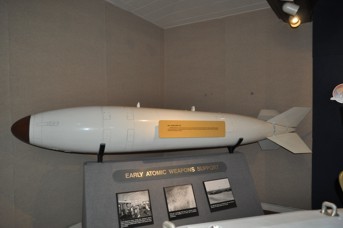 |
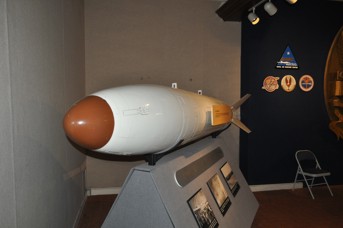 |
 |
Mark 15
Length:
11 7
Diameter:
2
10Ύ
Weight:
7,600 lbs
Yield: 1
to 2mt
Notes:
(USAF photo)
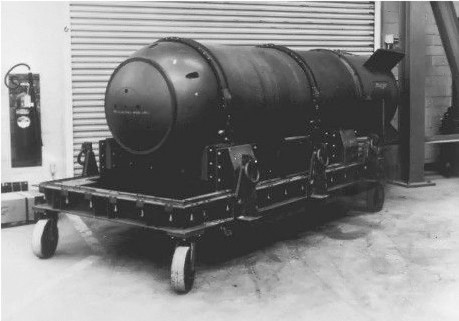 |
Length: 12' 11"
Diameter: 1' 10"
Weight: 1,200 lbs
Yield: 12 to 14kt
Mark 17
Length:
24 9½
Diameter:
5
1½
Weight: 41,400 lbs
Yield:
15mt
Notes:
The
Mk 17 was the largest thermonuclear weapon fielded by the United
States. Developed to be delivered by the
B-36 the massive weapon would only fit into the bomb bay
of a B-52 with mere inches to spare. The bottom two photos
show a Mark 17 next to a B-36J and another next to a
B-52B. Those photos give some idea of the size of
the Mk 17.
 |
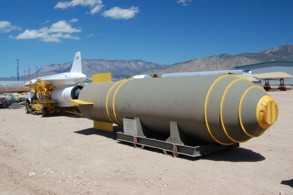 |
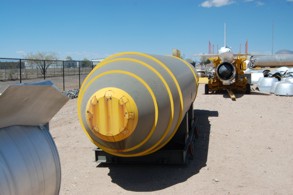 |
 |
 |
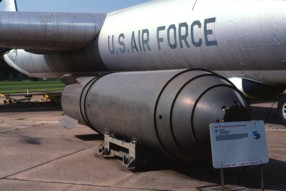 |
 |
 |
 |
Mark 21
Length:
12 5Ύ
Diameter:
4
10½
Weight: 17,500 lbs
Yield:
10mt
Notes:
Rebuilt as Mark 36. Photos under the Mark 36 entry.
Mark 27
Length:
11 9½
Diameter:
2
6Ό
Weight: 3,150 lbs
Yield:
Megaton class
Notes:
 |
Mark 28-External
Length:
14 2½
Diameter:
1
8
Weight: 2,040 lbs
Yield:
Variable
Notes: Carried externally; no
parachute
Mark 28-Full Fusing
Internal
Length:
12 1Ό
Diameter:
1
10
Weight: 2,240 lbs
Yield:
Variable
Notes: Carried internally; equipped
with one afoot pilot chute, one 16 foot and one 24 foot
chute
Mark 28-Internal
Length:
8
Diameter:
1
8
Weight: 1,980 lbs
Yield:
Variable
Notes:
Carried internally; no parachute
Mark 28-Retarded
External
Length:
13 9½
Diameter:
1
8
Weight: 2,170 lbs
Yield:
Variable
Notes: Carried externally; equipped
with one afoot pilot chute and one 28 foot ribbon chute
Mark 28-Retarded
Internal
Length:
12 3
Diameter:
1
10
Weight: 2,340 lbs
Yield:
Variable
Notes: Carried internally; equipped
with one afoot pilot parachute, one 16.5 foot ribbon
extraction chute, one 64 foot solid chute, and one 30 inch
stabilization chute
Mark 36
Length:
12 5Ύ
Diameter:
4
10½
Weight: 17,500 lbs
Yield:
Megaton class
Notes:
Mark 39
Length:
11 6
Diameter:
2
10½
Weight: 6,600 lbs
Yield:
4mt
Notes:
Mark 41
Length:
12 4Ύ
Diameter: 4 2
Weight:
10,670 lbs
Yield:
Megaton class
Notes:
Length:
124Ύ
Diameter:
4
2
Weight: 8,800 lbs
Yield:
9mt
Notes:
B-11/Mark 91
Length:
12 2½
Diameter:
1
2
Weight: 3.343
Yield:
Kiloton class
Notes:
B-43
Length:
12 6
Diameter:
1
6
Weight: 2,100 lbs
Yield: 1
to 2mt
Notes:
Mark 57/B-57
Length:
9 9½
Diameter:
1
2Ύ
Weight: 510 lbs
Yield: 5
to 10kt
Notes:
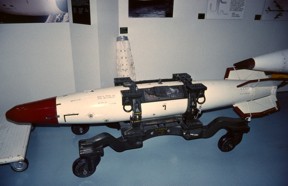 |
 |
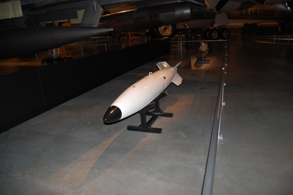 |
 |
B-61
Length:
11 9½
Diameter:
1
2Ύ
Weight: 710 lbs
Yield:
Variable 100 to 500kt
Notes:
 |
 |
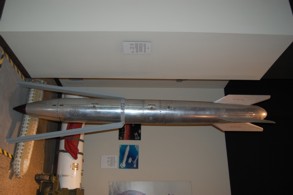 |
 |
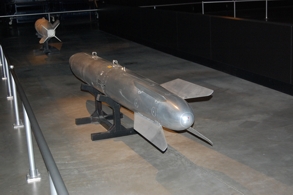 |
B-83
Length:
12
Diameter:
18
Weight: 2,408 lbs
Yield:
Variable
Notes:
 |
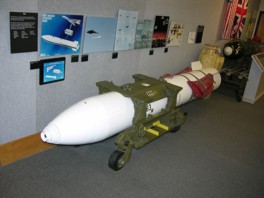 |
Mark 90 Betty
Length: 10 2
Diameter: 2 7½
Weight: 1,243 lbs
Yield: 5 to 10kt
Notes:
Mark 101 LuLu
Length: 7 6
Diameter: 1 6
Weight: 1,200 lbs
Yield: 10kt
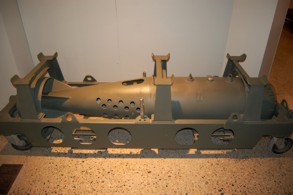 |
 |
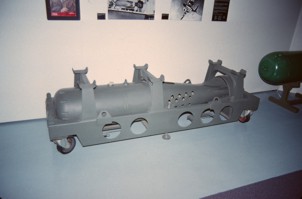 |
 |
Mark 105 HOTPOINT
Length: 8
(Internal) 12 (External)
Diameter: 1 7
Weight: 1,500 lbs
Yield: Low Kiloton
Notes: The HOTPOINT
could be configured with different nose and tail sections to
better suit various aircraft types.
AGM-62 WALLEYE
Length: 11 3
Diameter: 1 3
Weight: 2,000 lbs
Yield: 100kt
Notes: The WALLEYE
has the appearance of a missile, but in fact is a guided glide
weapon with a range of 16 to 35 miles depending on the
version.
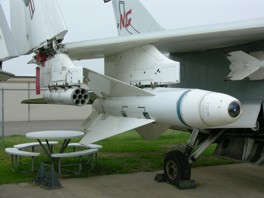 |
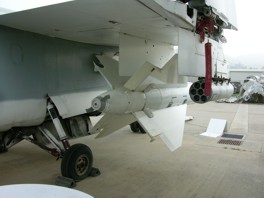 |
 |
 |
 |
| U S Air Force | ||||||||||||||||||||||||||
| Mark | A-7 | F-84G | F-84F | F-86H | F-100 | F-101 | F-104 | F-105 | F-4 | F-111 | F-15 | F-16 | B-29 | B-50 | B-45 | B-36 | B-47 | B-52 | B-57 | B-58 | B-66 | FB-111 | B-70 | B-1B | B-2 | |
| 1 | X | |||||||||||||||||||||||||
| 3 | X | X | X | |||||||||||||||||||||||
| 4 | X | X | X | |||||||||||||||||||||||
| 5 | X | X | X | X | X | X | ||||||||||||||||||||
| 6 | X | X | X | X | X | |||||||||||||||||||||
| 7 | X | X | X | X | X | X | X | |||||||||||||||||||
| 8 | X | |||||||||||||||||||||||||
| 12 | ||||||||||||||||||||||||||
| 14 | ||||||||||||||||||||||||||
| 15 | X | X | ||||||||||||||||||||||||
| 17 | X | X | ||||||||||||||||||||||||
| 18 | X | X | X | X | X | |||||||||||||||||||||
| 21 | X | |||||||||||||||||||||||||
| 24 | X | |||||||||||||||||||||||||
| 27 | ||||||||||||||||||||||||||
| 28EX | X | X | X | X | X | |||||||||||||||||||||
| 28FI | X | X | X | X | ||||||||||||||||||||||
| 28IN | X | X | X | X | X | |||||||||||||||||||||
| 28RE | X | X | X | X | X | |||||||||||||||||||||
| 28RI | X | X | X | X | X | |||||||||||||||||||||
| 36 | X | X | ||||||||||||||||||||||||
| 39 | X | X | X | ? | ||||||||||||||||||||||
| 41 | X | X | ||||||||||||||||||||||||
| 53 | X | X | X | X | ||||||||||||||||||||||
| 57 | X | |||||||||||||||||||||||||
| B-43 | X | X | X | X | X | X | X | X | X | X | X | X | X | X | ? | X | X | |||||||||
| B-61 | X | X | X | X | X | X | X | X | X | ? | X | X | ||||||||||||||
| B-83 | X | X | X | X | X | X | X | ? | X | X | ||||||||||||||||
| AGM-62 | X | X | X |
X |
||||||||||||||||||||||
| U S Navy | ||||||||||||||||||||||||||
| Mark | AD-1 | AJ | A3D | A-4 | A-5 | A-6 | A-7 | AV-8 | F2H | FJ-4B | F3H-2 | F9F-8 | F-4 | F-18 | H-3 | P5M | P6M | P-2 | P-3 | S-2 | S-3 | |||||
| 1 | X | |||||||||||||||||||||||||
| 3 | ||||||||||||||||||||||||||
| 4 | X | |||||||||||||||||||||||||
| 5 | X | X | ||||||||||||||||||||||||
| 6 | X | |||||||||||||||||||||||||
| 7 | X | X | X | X | X | |||||||||||||||||||||
| 8 | X | X | X | X | X | X | ||||||||||||||||||||
| 12 | X | X | X | X | X | X | X | X | ||||||||||||||||||
| 14 | ||||||||||||||||||||||||||
| 15 | X | X | ||||||||||||||||||||||||
| 17 | ||||||||||||||||||||||||||
| 18 | X | |||||||||||||||||||||||||
| 21 | ||||||||||||||||||||||||||
| 24 | ||||||||||||||||||||||||||
| 27 | X | X | ||||||||||||||||||||||||
| 28EX | X | X | X | X | ||||||||||||||||||||||
| 28FI | ||||||||||||||||||||||||||
| 28IN | X | X | ||||||||||||||||||||||||
| 28RE | X | X | X | X | ||||||||||||||||||||||
| 28RI | X | X | ||||||||||||||||||||||||
| 36 | ||||||||||||||||||||||||||
| 39 | ||||||||||||||||||||||||||
| 41 | ||||||||||||||||||||||||||
| 53 | X | |||||||||||||||||||||||||
| 57 | X | X | X | X | X | X | X | X | ||||||||||||||||||
| 90 | X | X | X | X | X | |||||||||||||||||||||
| B-11/91 | X | X | X | X | ||||||||||||||||||||||
| 101 | X | X | X | X | X | X | X | X | X | |||||||||||||||||
| 105 | X | X | X | X | X | |||||||||||||||||||||
| B-43 | X | X | X | X | X | |||||||||||||||||||||
| B-61 | X | X | X | X | X | |||||||||||||||||||||
| B-83 | X | X | X | X | ||||||||||||||||||||||
| AGM-62 | X | X | X | X | ||||||||||||||||||||||
|
|||||||||||||||||||||||||||||||||||||||||||||||||||||||||||||||||||||||||||||||||||||||||||||||||||||||||||||||||||||||||||||||||||||||||||||||||||||||||||||||||||||||||||||||||||
Page
created: 04-25-09
Modified:
11-23-14